Flower of Love by Marisa Srijunpleang

Blooms when the wind blows At the Hub of Photography, Bangkok takes an autoethnographic look at the natural world
Last year, emerging Thai-Khmer artist Marisa Srijunpleang won the Bangkok Art and Culture Centre’s sixth Early Years Project for an excavation of family history that delved deep into the painful recesses of her relatives’ pasts – so much so that the project was named after the immigration number her aunt received when she sought asylum in the United States after the Cambodian genocide. An installation focusing on family testimonies, photographs, letters and gatherings, T360174 (2023) was an attempt to publicly delineate and internalize the rarely mentioned events that happened to Srijunpleang’s aunt and grandparents in 1975, when they became stranded in Cambodia on a short trip across the border from Thailand’s Surin province. The poignant video component paired her aunt’s memories of her daily struggle for survival during the four-year rule of the murderous Khmer Rouge with footage of the family as it exists today, gathering wildflowers and preparing offerings for an ancestor worship ceremony known as sandonta, unique to the region.
Srijunpleang’s first solo exhibition expands on this autoethnographic basis by reducing it to its earthy floral component: arranged on the walls is an intimate photographic study of the grass flowers that grow along the Thai-Cambodian border near her family home. Most of the 15 images depict disordered clumps of white-tipped grass flowers sprouting amid the knotted, parched terrain of sun-scorched bushland—bushes and thickets that, to my eyes, vaguely recall the chalk outlines of a recent murder scene, the silhouettes of corpses that decomposed there and as they fell, or the thickets that rise insidiously over forgotten graves.

Today, another civil war is raging on another Thai border: since 2021, more than three million people have been displaced and tens of thousands killed in Myanmar. Given that villagers and revolutionaries are hiding and dying in Myanmar’s jungles at this very moment, it is hard not to look at these melancholy images through that lens. Yet there is something life-affirming, not merely funereal, about them. As she trekked through the inhospitable borderlands of Surin, across a land that was a vulnerable border—a realm of limbo, poverty, and death—ruled by armies and refugee camps during and after Khmer Rouge rule, and where “there were bombs everywhere, just like in the movies” (as another aunt puts it in the video documentary), Srijunpleang found herself drawn to these hardy plants. Their weighty, if somewhat overstuffed, titles like Be strong under the sun, Rau And Determined with the wind (both 2024) broadly suggest what her subjects say in the elegiac world of transience and loss into which she draws us through a sparse interplay of image and text: these flowers are at once placeholders for those thrown off course by war, memories nourished by the tainted earth, and representations of her family’s indomitable spirit.
The core interests underlying Srijunpleang’s work – an animistic attunement to the spirits of inanimate objects and charged landscapes and a desire to restore familial bonds and traditions – are most strongly embodied by the exhibition’s titular ritual centrepiece: a cone of feathered dok rak (crown flower) seeds arranged on a round acrylic base and illuminated from above for dramatic effect. Since many details of the war are still unspoken, Srijunpleang has used the Sandonta ceremony as a means of connecting with other forms of local knowledge that lie in the past but have also been partially lost. Here the fluffy white seed of the dok rak – A ‘Flower of Love’ often used in phuang malai (Thai flower garlands) – fills the gap left by Phaka Bai Ben – a seasonal flower once used in rites of homage but no longer grown in the region – to moving effect. After seeing them floating in the air during her journey and sensing an indescribable meaning in them, Srijunpleang transformed what is usually an offering to ancestral spirits – a simple, decorative floral arrangement built around a banana leaf cone – into what looks like a rare family gathering or reunion.
Blooms when the wind blows at HOP – Hub of Photography, Bangkok, until 21 July



